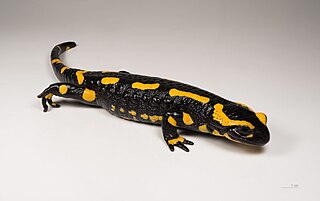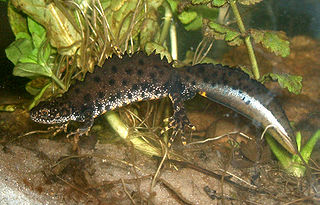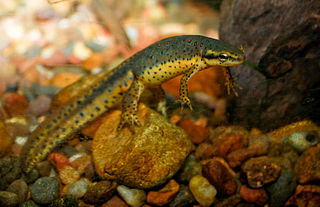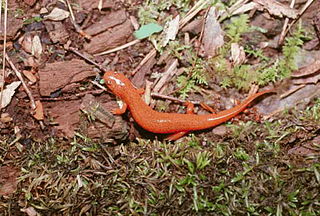
The palmate newt is a species of newt found in Western Europe, from Great Britain to the northern Iberian peninsula. It is 5–9.5 cm (2.0–3.7 in) long and olive or brown with some dark spots. The underside is yellow to orange, and the throat, unlike in the similar smooth newt, always unspotted. A dark stripe runs along the head and through the eyes. Breeding males develop a distinct filament on the end of their tail, strongly webbed hind feet, and a low, smooth crest on their back.

The fire salamander is a common species of salamander found in Europe.

The northern crested newt, great crested newt or warty newt is a newt species native to Great Britain, northern and central continental Europe and parts of Western Siberia. It is a large newt, with females growing up to 16 cm (6.3 in) long. Its back and sides are dark brown, while the belly is yellow to orange with dark blotches. Males develop a conspicuous jagged crest on their back and tail during the breeding season.

The sword-tail newt, sword-tailed newt, yellow-bellied newt, or Okinawa newt is a species of true salamander from the Ryukyu Archipelago in Japan.

The eastern newt is a common newt of eastern North America. It frequents small lakes, ponds, and streams or nearby wet forests. The eastern newt produces tetrodotoxin, which makes the species unpalatable to predatory fish and crayfish. It has a lifespan of 12 to 15 years in the wild, and it may grow to 5 in (13 cm) in length. These animals are common aquarium pets, being either collected from the wild or sold commercially. The striking bright orange juvenile stage, which is land-dwelling, is known as a red eft. Some sources blend the general name of the species and that of the red-spotted newt subspecies into the eastern red-spotted newt.

Triturus is a genus of newts comprising the crested and the marbled newts, which are found from Great Britain through most of continental Europe to westernmost Siberia, Anatolia, and the Caspian Sea region. Their English names refer to their appearance: marbled newts have a green–black colour pattern, while the males of crested newts, which are dark brown with a yellow or orange underside, develop a conspicuous jagged seam on their back and tail during their breeding phase.

The California newt or orange-bellied newt, is a species of newt endemic to California, in the Western United States. Its adult length can range from 5 to 8 in. Its skin produces the potent toxin tetrodotoxin.

The Pyrenean brook salamander or Pyrenean newt, , is a largely aquatic species of salamander in the family Salamandridae. It is found in the Pyrenees of Andorra, France, and Spain. The IUCN lists it as least concern.

The Sardinian brook salamander or Sardinian mountain newt is a species of salamander in the family Salamandridae found only in Sardinia, Italy.

The Corsican fire salamander is a species of salamander in the family Salamandridae found only on the island of Corsica as an endemic species. In former times, this species was known as a subspecies of the widespread but continental-distributed fire salamander, which may appear quite similar.

The Tyrrhenian painted frog is a species of frog in the family Alytidae.
Pseudoeurycea smithi, commonly known as Smith's false brook salamander, is a species of salamander in the family Plethodontidae. It is endemic to certain mountainous regions of Mexico. Its natural habitat is subtropical or tropical moist montane forests. It is threatened by habitat loss.

The mud salamander is a bright red salamander of the family Plethodontidae. It is found in streams, seeps and swamps and underneath logs, rocks and leaves. It is endemic to the eastern half of the United States with one isolated population in central Mississippi. Mud salamanders are rarely seen plethodontids that inhabit muddy wetland and riparian habitats. Mud salamanders don’t generally live above 700 meters in elevation in the Appalachian Mountains, resulting in two geographically isolated populations. Mud salamanders have short stocky bodies ranging from 7.5 to 16 cm long. Body color ranges with age and locality. There are four subspecies in the mud salamander complex, namely the Gulf Coast mud salamander, rusty mud salamander, Midland mud salamander and the eastern mud salamander. Mud salamanders are ectothermic, meaning that they cannot control their body temperature and it fluctuates with the temperature. The mud salamander is readily confused with two other species, the red salamander and the spring salamander.

A newt is a salamander in the subfamily Pleurodelinae. The terrestrial juvenile phase is called an eft. Unlike other members of the family Salamandridae, newts are semiaquatic, alternating between aquatic and terrestrial habitats. Not all aquatic salamanders are considered newts, however. More than 100 known species of newts are found in North America, Europe, North Africa and Asia. Newts metamorphose through three distinct developmental life stages: aquatic larva, terrestrial juvenile (eft), and adult. Adult newts have lizard-like bodies and return to the water every year to breed, otherwise living in humid, cover-rich land habitats.

The Coastal Range newt is a subspecies of the California newt. It is endemic to California, from Mendocino County south to San Diego County.

The Montseny brook newt is a species of salamander in the family Salamandridae. It is endemic to the Montseny Massif in northeast Spain. Before it was formally described in 2005, it was mixed with the larger and more widely distributed Pyrenean brook salamander.

The Acqua Tignese is a stream in the Haute-Corse department of the Corsica region that has its mouth north of Cap Corse, in the Ligurian Sea.

The Ospedale Reservoir is a reservoir in the Corse-du-Sud department of France on the island of Corsica. It holds drinking water for the southeast of the island, including Porto-Vecchio. It is surrounded by a forest that has been designated a Zone naturelle d'intérêt écologique, faunistique et floristique (ZNIEFF).


















